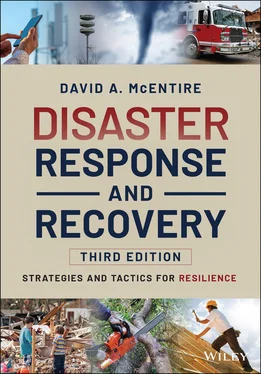David A. McEntire - Disaster Response and Recovery
Здесь есть возможность читать онлайн «David A. McEntire - Disaster Response and Recovery» — ознакомительный отрывок электронной книги совершенно бесплатно, а после прочтения отрывка купить полную версию. В некоторых случаях можно слушать аудио, скачать через торрент в формате fb2 и присутствует краткое содержание. Жанр: unrecognised, на английском языке. Описание произведения, (предисловие) а так же отзывы посетителей доступны на портале библиотеки ЛибКат.
- Название:Disaster Response and Recovery
- Автор:
- Жанр:
- Год:неизвестен
- ISBN:нет данных
- Рейтинг книги:5 / 5. Голосов: 1
-
Избранное:Добавить в избранное
- Отзывы:
-
Ваша оценка:
- 100
- 1
- 2
- 3
- 4
- 5
Disaster Response and Recovery: краткое содержание, описание и аннотация
Предлагаем к чтению аннотацию, описание, краткое содержание или предисловие (зависит от того, что написал сам автор книги «Disaster Response and Recovery»). Если вы не нашли необходимую информацию о книге — напишите в комментариях, мы постараемся отыскать её.
The new edition of the standard textbook in the field, updated with new studies and practical guidelines for reacting to the complexities of today’s disasters Disaster Response and Recovery: Strategies and Tactics for Resilience
Disaster Response and Recovery: Strategies and Tactics for Resilience, Third Edition
Disaster Response and Recovery — читать онлайн ознакомительный отрывок
Ниже представлен текст книги, разбитый по страницам. Система сохранения места последней прочитанной страницы, позволяет с удобством читать онлайн бесплатно книгу «Disaster Response and Recovery», без необходимости каждый раз заново искать на чём Вы остановились. Поставьте закладку, и сможете в любой момент перейти на страницу, на которой закончили чтение.
Интервал:
Закладка:
Each of these events has prompted additional discussion about mental health and gun control issues. They have also created a need for better prepared police officers and emergency medical technicians. Mass shootings illustrate that emergency managers must not overlook the potential impact of deranged individuals who take pleasure in inflicting mass death upon others.
For Example
Las Vegas Shooting
During October 1, 2017, Stephen Paddock opened fire from the 32nd floor of the Mandalay Bay Hotel onto the crowd below that was enjoying the Route 91 Harvest Music Festival. The 64‐year‐old man used multiple rifles to shoot over 1,000 rounds of ammunition. Sixty people died and 411 were wounded from this mass shooting, and scores of others were injured as they tried to escape and protect their life. This event is the deadliest mass shooting in the United States, and it prompted the ban of “bump stocks” which produce rapid fire almost equivalent to automatic weapons. Paddock’s motive remains unknown to this day.
1.4.4 Terrorism
Terrorism has been one of the most‐deadly civil/conflict hazards throughout history, and it has become even more pronounced over the past few decades. Terrorismis the threat or use of violence to intimidate someone or a government. The perpetrators usually have ideological motives and a political objective to achieve. For instance, terrorists engage in threatening and violent behavior to seek independence, promote their religion, protest abortions, or protect the environment. Terrorists have used guns, arson, bombings, and other measures to kill and disrupt the activities of others. Their attacks have occurred around the world and often target busses, trains or other highly populated areas. Suicide bombings are common in the Middle East, particularly in Israel. Other major attacks with bombings have occurred in Spain, Germany, Russia, the United Kingdom, Iraq, Afghanistan, and Kenya.
Several terrorist attacks have directly affected the United States and were perpetrated by American citizens. For instance, Eric Rudolph planted bombs at the Centennial Olympic Park in Atlanta on July 27, 1996. The blast killed 1 person but injured more than 100 others. Timothy McVeigh bombed the Alfred P. Murrah Building in Oklahoma City in 1995. His attack killed 168 people, which included many children at a daycare in the building.
Other terrorist events have been perpetrated by foreign and/or religious extremists. In 1993, the World Trade Center in New York City was attacked with a bomb placed in a van in an underground parking lot. During the 2013 Boston Marathon, two brothers used homemade bombs made out of pressure cookers to cause mayhem, death, and injuries near the finish line of the race. On December 2, 2015, a married couple entered the Inland Regional Center in San Bernardino, California, during a combined County Public Health Training event and Christmas party. They shot and killed 14 people and injured 22 others. About 4 hours later, police confronted the perpetrators and they were killed in a shootout. On June 12, 2016, Omar Mateen killed 49 people and injured over 50 others in a mass shooting at the Pulse nightclub in Orlando, Florida.
Of course, the worst case of terrorism in the United States was on September 11, 2001. Islamic extremists hijacked four planes and used them as missiles against buildings symbolic of U.S. political, military, and economic interests. The World Trade Centers were the main targets of the planes. The towers collapsed after the ignited jet fuel weakened the structure. Thousands of people died and several buildings in New York were turned into a pile of broken glass, twisted metal, and other dangerous and unhealthy debris. The Pentagon was also struck during the attack, but fewer people died in this building than in the World Trade Centers in New York. One plane was also intentionally crashed in Pennsylvania, and it is assumed that this aircraft was headed to the White House or Capitol Hill.
Criminals and terrorists increasingly seek novel ways to attack their enemies, including through the use of weapons of mass destruction (e.g., nerve, blister, blood, and choking and incapacitating agents). A significant terrorist attack in 1995 involved the use of sarin gas by the Aum Shinrikyo cult in Japan. This event, which occurred in a subway, resulted in the death of several people. It also created massive medical care needs—whether real or imagined—for thousands of others. The use of Sarin gas illustrated the grave potential of biological, chemical and nuclear weapons. Sadly, others have followed suit. Shortly after 9/11, envelopes containing anthrax were sent via mail to the headquarters of a newspaper in Florida and to Congressional leaders in Washington, DC. This attack disabled the postal service for days and killed a handful of people. In April 2013, a woman from East Texas sent an envelope containing ricin to President Obama. The individuals involved in these incidents were identified. The first person committed suicide and the other has been imprisoned for her actions.
Not all future terrorist attacks will involve weapons of mass destruction. Recently, some far‐right groups and white supremacy organizations tried to kidnap the Governor of Michigan and they have driven vehicles into peaceful protestors. Many of their plans have been foiled, but the FBI is concerned about terrorist attacks emanating from these and other extremists in the future. Regardless of the cause, the rising threat of terrorism has prompted a significant reorganization of the U.S. government and the establishment of the Department of Homeland Security. Billions of dollars have been poured into first responder training and public health preparedness measures as a result.
For Example
Manchester Bombing
In June 1996, terrorists parked a vehicle near a major intersection in the commercial district of Manchester, England. A local television station received word that an explosive would be detonated. A bomb squad was brought in, but team was not able to dismantle the explosives. However, the city was able to evacuate 80,000 people from the area. No one died in the attack, but it did injure over 200 people who were cut by glass, impaled by objects or otherwise affected by the blast. Several buildings were damaged or destroyed, and many businesses and apartment dwellers lost office space or residences. This intentional disaster cost millions of dollars in direct and indirect losses. It prompted a major emergency response and criminal investigation.
1.4.5 War
Conflict has occurred throughout history between different tribes, ethnic groups, and nation‐states. Millions of people have been killed due to serious disagreements when negotiations break down and violence ensues. With the advent of modern weaponry, however, the stakes of fighting have become much higher. For instance, entire cities have been leveled. Such was the case in World War II when London, Dresden, Hiroshima, and Nagasaki were bombed with conventional or nuclear explosives. Shortly thereafter and during the Cold War, the fear of a nuclear attack from the Soviet Union prompted the United States to invest heavily in civil defense initiatives. The goal was to prepare for such an attack, stockpile supplies, and evacuate and shelter citizens if required.
Perhaps there are fewer world wars today as compared to the past, but notable exceptions exist. There has been a great deal of intrastate fighting as in places such as Somalia, Yugoslavia, Rwanda, Libya and Syria. These internal civil wars are known as “complex emergencies.” They typically involve ethnic cleansing, a failed government, and economic turmoil that are sometimes combined with natural and environmental disasters and especially famines. Those responding to such events have been targeted by the warring factions. For example, relief workers in Iraq have been kidnapped and killed by the belligerent parties.
Читать дальшеИнтервал:
Закладка:
Похожие книги на «Disaster Response and Recovery»
Представляем Вашему вниманию похожие книги на «Disaster Response and Recovery» списком для выбора. Мы отобрали схожую по названию и смыслу литературу в надежде предоставить читателям больше вариантов отыскать новые, интересные, ещё непрочитанные произведения.
Обсуждение, отзывы о книге «Disaster Response and Recovery» и просто собственные мнения читателей. Оставьте ваши комментарии, напишите, что Вы думаете о произведении, его смысле или главных героях. Укажите что конкретно понравилось, а что нет, и почему Вы так считаете.












